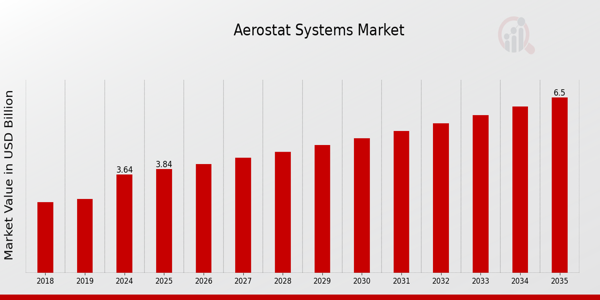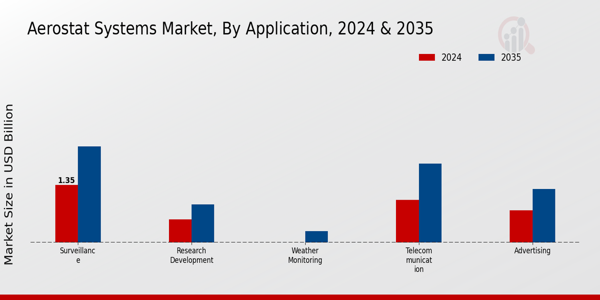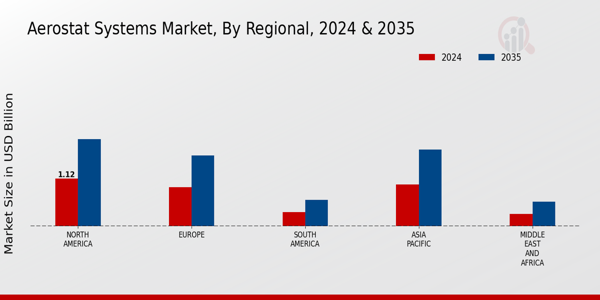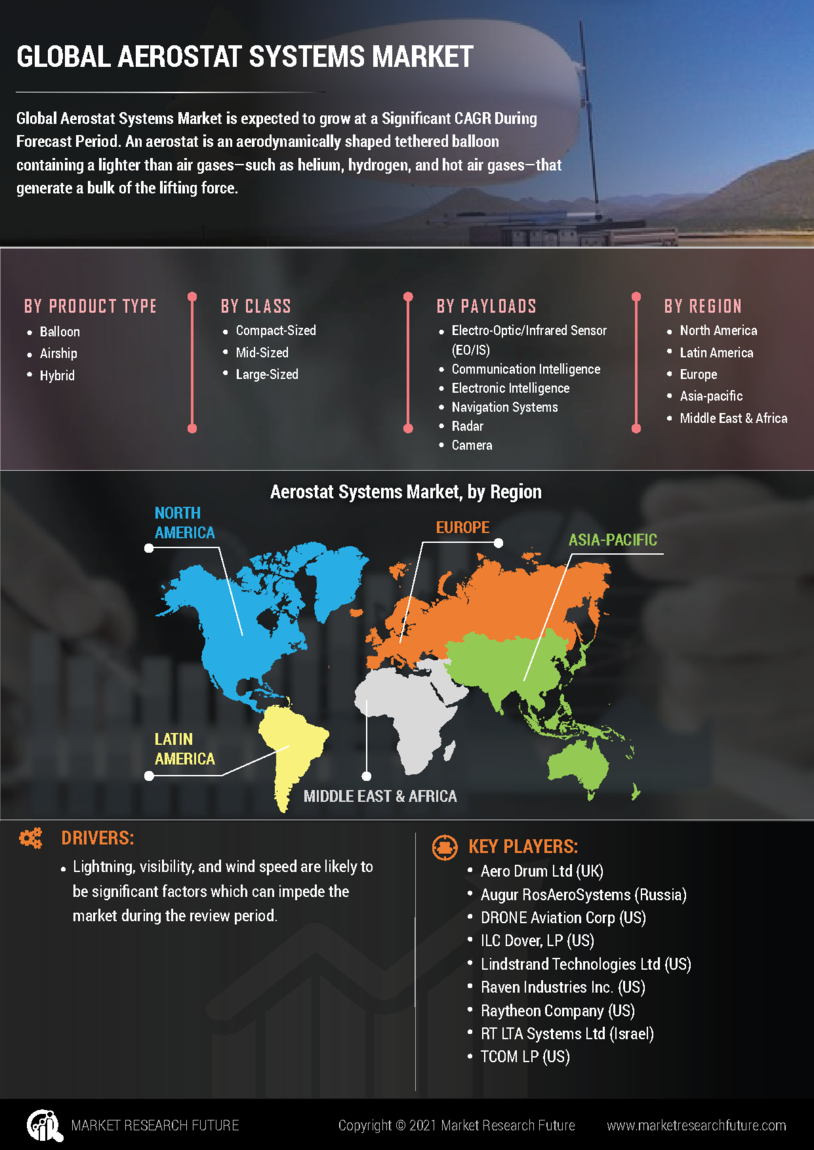Aerostat Systems Market Summary
As per Market Research Future Analysis, the Global Aerostat Systems Market was valued at 3.46 USD Billion in 2023 and is projected to reach 6.5 USD Billion by 2035, growing at a CAGR of 5.41% from 2025 to 2035. The market is driven by increasing demand for surveillance and monitoring solutions, particularly in defense and security applications, as governments invest in modernizing their surveillance capabilities. Technological advancements and rising defense budgets globally further support market growth.
Key Market Trends & Highlights
The Aerostat Systems Market is witnessing significant trends driven by technological advancements and increasing security needs.
- The market is expected to grow from 3.64 USD Billion in 2024 to 6.5 USD Billion by 2035.
- Surveillance applications are projected to grow from 1.35 USD Billion in 2024 to 2.25 USD Billion by 2035.
- Technological innovations are reducing operational costs by approximately 20%, enhancing market appeal.
- Global military expenditures exceeded 2 trillion USD, driving demand for advanced surveillance systems.
Market Size & Forecast
2023 Market Size: USD 3.46 Billion
2024 Market Size: USD 3.64 Billion
2035 Market Size: USD 6.5 Billion
CAGR (2025-2035): 5.41%
Largest Regional Market Share in 2024: North America.
Major Players
Key players include DLR, SAIC, Lockheed Martin, Lindstrand Technologies, Aeroscraft, Goodyear Airship Management Services, General Dynamics, TCOM, Northrop Grumman, Raytheon Technologies, AVIC, Frequentis, Boeing, and Thales Group.
Key Aerostat Systems Market Trends Highlighted
The Aerostat Systems Market is now seeing major trends that are being driven by the developments in technology as well as the rising need for surveillance and monitoring solutions. One of the most important market drivers is the growing need for aerial surveillance in the context of defense and security applications.
As part of their efforts to strengthen national security, governments all over the world are making significant investments in the modernization of their surveillance capabilities. This includes the deployment of aerostat systems for the purpose of border security and disaster management.
As the importance of security continues to rise, there has been a notable rise in the utilization of aerostats, which are able to offer continuous aerial surveillance. There are still plenty of opportunities available in the global market for aerostat systems, particularly in industries such as environmental monitoring and telecommunications.
Aerostats have the potential to improve communication in remote locations where traditional infrastructure is inadequate. This is because governments are working to improve their internet infrastructure.
Furthermore, the capability of aerostat systems to detect environmental changes might be of assistance in disaster management and climate monitoring activities, which presents substantial prospects for the growth of the market. There has been a recent trend in aerostat systems that indicates a shift towards more inventive designs and novel technology.
It is clear that there is a significant amount of interest in hybrid systems that mix drones and aerostats in order to achieve greater operational efficiency. In addition, aerostats have become more adaptable and cost-effective as a result of developments in materials and lightweight designs.
Not only does this trend improve functionality, but it also lowers the total running cost, which makes them an appealing choice for a variety of applications. In general, the Aerostat Systems Market is well positioned for expansion, which is being driven by the aforementioned market trends as well as the numerous opportunities that are ready to be explored in the always shifting technological landscapes.

Source: Primary Research, Secondary Research, Market Research Future Database and Analyst Review
Aerostat Systems Market Drivers
Growing Demand for Surveillance and Monitoring Solutions
The Aerostat Systems Market is significantly driven by the increasing need for surveillance and monitoring solutions across various sectors including defense, border security, and emergency response. According to the Global Security Industry Alliance, the demand for advanced surveillance systems has grown by approximately 30% over the last five years due to escalating security concerns globally.
As countries enhance their focus on national security, platforms such as aerostats provide a cost-effective alternative for aerial surveillance, allowing for persistent observation without the high costs associated with traditional aircraft.
Countries like the United States and India are investing heavily in aerostat systems to bolster their monitoring capabilities, where systems such as the Persistent Surveillance Systems and Blue Devil have shown demonstrable effectiveness in operations.
This increasing commitment indicates a robust and sustained demand in the Aerostat Systems Market, paving the way for remarkable growth in the coming years.
Technological Advancements in Aerostat Systems
The evolution of technology within the Aerostat Systems Market is another significant driver for growth. Innovations in materials such as lightweight composites and advanced helium storage solutions have enhanced the efficiency and performance of aerostat systems.
Recent trends indicate that these advancements can lead to a reduction in operational costs by around 20%, making them more appealing to potential buyers. Major aerospace corporations, including Lockheed Martin and Raytheon, have been instrumental in this tech drive, with developments in systems that now come equipped with superior imaging technology and enhanced payload capabilities.
The ongoing Research and Development efforts in various countries are expected to push the boundaries of aerostat capabilities, suggesting a promising trajectory for market growth as new technologies are continuously introduced.
Increasing Defense Budgets Globally
An essential driver influencing the Aerostat Systems Market is the rise in defense budgets across various nations. According to data from the Stockholm International Peace Research Institute, global military expenditures exceeded 2 trillion USD in recent years, with nations like China and Russia significantly increasing their defense spending.
This trend is pushing governments to seek innovative solutions such as aerostat systems for surveillance and reconnaissance purposes. Countries that are heavily investing in their defense capabilities are more likely to incorporate aerostat technology into their operations.
For instance, Brazil and Saudi Arabia have announced multi-year defense plans which specifically mention the procurement of advanced surveillance systems, further driving demand for aerostat deployments. This increasing reliance on aerial surveillance directly influences the growth of the Aerostat Systems Market, reflecting a positive outlook for the industry.
Aerostat Systems Market Segment Insights
Aerostat Systems Market Application Insights
The Aerostat Systems Market experienced noteworthy growth, especially across various applications that are critical in addressing contemporary needs.
In 2024, the market value for the Surveillance application reached 1.35 USD Billion, growing to 2.25 USD Billion by 2035, reflecting a majority holding and showcasing its significant role in enhancing security measures and monitoring activities across various sectors.
The value of the Advertising application stood at 0.75 USD Billion in 2024, projected to increase to 1.25 USD Billion in 2035, underlining its importance in innovative advertising strategies that utilize aerial visibility for brand promotion.
When considering the Telecommunication application, it was valued at 1.0 USD Billion in 2024 and is expected to reach 1.85 USD Billion by 2035, emphasizing its growing relevance in providing communication networks in areas lacking infrastructure, thus reducing connectivity gaps.
As for the Research and Development application, its market value was 0.54 USD Billion in 2024, expected to rise to 0.89 USD Billion in 2035, highlighting its role in scientific investigations and technological advancements that expand our understanding of various fields.
Lastly, the Weather Monitoring application, although initiating at 0.0 USD Billion in 2024, anticipates reaching 0.26 USD Billion by 2035, signifying an emerging segment that will play a vital role in improving weather forecasting and disaster preparedness.
The comprehensive insights into these segments will guide stakeholders in recognizing opportunities as well as challenges in the Aerostat Systems Market, with emphasis on the increasing demand for surveillance solutions owing to growing safety concerns along with the need for reliable communication networks.

Source: Primary Research, Secondary Research, Market Research Future Database and Analyst Review
Aerostat Systems Market Type Insights
The Aerostat Systems Market, focusing on the Type segment, encompasses a diverse range of systems that cater to various applications in surveillance, telecommunications, and reconnaissance. Among the types, Unmanned Aerostat Systems are particularly significant due to their operational efficiency and lower operational costs, contributing to their major role in contemporary applications.
Manned Aerostat Systems, while less prevalent, offer unique capabilities in specific scenarios where human presence is essential for decision-making and adaptability. Hybrid Aerostat Systems combine the advantages of both unmanned and manned systems, positioning them as versatile solutions for varied operational demands.
The Aerostat Systems Market segmentation reveals that advancements in technology and growing investments in Research and Development are essential growth drivers. Additionally, challenges such as regulatory compliance and operational limitations could impact market progress.
Overall, the trends indicate a strong potential for growth in this sector, with numerous opportunities emerging from defense and homeland security initiatives on a global scale.
Aerostat Systems Market Balloon Type Insights
The Aerostat Systems Market revenue is significantly driven by the Balloon Type segment. This segment primarily includes Tethered Aerostats, Free-Flying Aerostats, and Hybrid Aerostats. Tethered Aerostats are vital for military surveillance and telecommunications, providing stationary platforms for various applications.
Free-Flying Aerostats offer mobility and versatility, making them suitable for scientific data collection and environmental monitoring. Hybrid Aerostats combine features of both tethered and free-flying types, allowing for improved operational capabilities and flexibility in deployment.
As the demand for surveillance, disaster management, and communication solutions rises globally, the market is experiencing steady growth, spurred by technological advancements and increasing government investment in defense and security sectors.
Challenges such as regulatory issues and operational limitations pose hurdles for market players, yet opportunities for integration with emerging technologies like AI and IoT provide pathways for innovation in the Aerostat Systems Market.
Moreover, enhanced data collection capabilities and low operational costs position the Balloon Type segment as a crucial component within the Aerostat Systems Market data landscape.
Aerostat Systems Market End-use Insights
The Aerostat Systems Market has been profoundly driven by diverse End-use applications, notably in Military, Commercial, and Civil sectors. The military domain plays a crucial role, leveraging aerostat systems for tactical reconnaissance and intelligence gathering, thus enhancing operational effectiveness.
The commercial sector increasingly adopts these systems for purposes like telecommunications and advertising, capitalizing on their ability to provide cost-effective, wide-range coverage. Meanwhile, the civil segment is expanding steadily, with applications in environmental monitoring and disaster management gaining traction globally.
This interplay among the different sectors signifies a balanced demand, where each segment contributes significantly to the increase of the Aerostat Systems Market revenue. The market's adaptability to innovative features strengthens its position within the Aerostat Systems Market.
Aerostat Systems Market Regional Insights
The Aerostat Systems Market revenue showed significant regional variations in 2024, with North America leading at 1.12 USD Billion, followed by Europe at 0.92 USD Billion, and Asia Pacific at 0.98 USD Billion.
South America and Middle East and Africa contributed smaller shares, valued at 0.33 USD Billion and 0.29 USD Billion, respectively. The growth dynamics revealed that North America dominated due to its advanced technological capabilities and high demand for aerostat systems in surveillance and defense applications.
Europe follows closely, showcasing strong growth driven by Research and Development activities and governmental support for defense modernization programs. Asia Pacific's market is supported by increasing investments in infrastructure development, while South America and the Middle East and Africa are gradually developing their aerostat capabilities, presenting opportunities for future growth.
Overall, the Aerostat Systems Market data indicated a robust expansion across all regions, driven by technological advances, strategic partnerships, and increased military expenditures, driven significantly by North America and Europe.

Source: Primary Research, Secondary Research, Market Research Future Database and Analyst Review
Aerostat Systems Market Key Players and Competitive Insights
The Aerostat Systems Market is characterized by a unique blend of traditional defense applications and progressive technologies driven by surveillance and communication needs. This market is witnessing heightened competition fueled by technological advancements, emerging applications, and the demand for efficient airborne systems.
As various stakeholders, including defense agencies and commercial enterprises, seek to deploy aerostats for diverse purposes such as troop surveillance, reconnaissance, and border patrol, the competitive landscape is evolving.
Companies in this space are innovating their offerings to capture larger market shares, enhance operational capabilities, and ensure compliance with regulatory standards, which adds complexity to their competitive strategies.
DLR has established a strong foothold in the Aerostat Systems Market thanks to its robust research and development capabilities as well as commitment to innovation. The organization's strength lies not only in its technical expertise but also in its collaborative relationships with key stakeholders, including government entities and industry partners.
This synergy allows DLR to leverage insights from various applications and integrate them into their aerostat systems. The company emphasizes continuous improvement and adaptability to customer needs, ensuring their offerings are aligned with current technological trends.
This focus on reliability and versatility positions DLR favorably within a competitive landscape that is increasingly leaning towards high-tech solutions.
SAIC is recognized for its substantial contributions to the Aerostat Systems Market, offering a range of advanced aerostat solutions that cater to surveillance, reconnaissance, and intelligence-gathering missions.
The company’s key products and services include sophisticated aerostat platforms designed for both military and commercial applications, enabling enhanced situational awareness. SAIC's strength lies in its extensive market presence backed by strategic mergers and acquisitions that have augmented its technological prowess and market reach.
The company continues to invest in research and development, ensuring its products remain at the forefront of innovation while effectively meeting customer demands. This strategic approach enables SAIC to maintain a competitive edge while broadening its influence in various global markets, positioning itself as a leader in the aerostat systems domain.
Key Companies in the Aerostat Systems Market Include
- DLR
- SAIC
- Lockheed Martin
- Lindstrand Technologies
- Aeroscraft
- Goodyear
- Airship Management Services
- General Dynamics
- TCOM
- Northrop Grumman
- Raytheon Technologies
- AVIC
- Frequentis
- Boeing
- Thales Group
Aerostat Systems Market Industry Developments
-
Q2 2024: Israel Aerospace Industries Wins Major Aerostat Surveillance Contract from Asian Government Israel Aerospace Industries announced it secured a multi-million dollar contract to supply advanced aerostat surveillance systems to an undisclosed Asian government, expanding its footprint in the defense sector.
-
Q2 2024: TCOM, L.P. Opens New Aerostat Manufacturing Facility in North Carolina TCOM, L.P., a leading aerostat manufacturer, inaugurated a new production facility in Elizabeth City, North Carolina, to meet growing demand for persistent surveillance solutions.
-
Q2 2024: ILC Dover Launches Next-Generation Helium-Efficient Aerostat System ILC Dover unveiled its latest aerostat platform featuring advanced lightweight composite materials, designed to reduce helium consumption and improve operational efficiency for military and commercial users.
-
Q3 2024: Raytheon Secures U.S. Army Contract for Aerostat-Based Border Surveillance Raytheon announced it was awarded a contract by the U.S. Army to deploy aerostat systems for enhanced border security and persistent surveillance along the southern border.
-
Q3 2024: Lockheed Martin Partners with U.S. Coast Guard for Maritime Aerostat Trials Lockheed Martin revealed a partnership with the U.S. Coast Guard to test aerostat-mounted radar systems for improved maritime object detection and coastal surveillance.
-
Q3 2024: Worldwide Aeros Corporation Announces New Hybrid Airship for Disaster Response Worldwide Aeros Corporation launched a new hybrid airship platform designed for rapid deployment in disaster response scenarios, offering high payload capacity and extended endurance.
-
Q4 2024: Aero Drum Ltd. Secures Funding for Expansion of Aerostat Production Aero Drum Ltd. announced a successful funding round to expand its aerostat manufacturing capabilities, targeting increased demand from European defense agencies.
-
Q4 2024: ILC Dover Appoints New CEO to Lead Aerostat Systems Division ILC Dover named a new Chief Executive Officer for its Aerostat Systems Division, aiming to accelerate innovation and global market expansion.
-
Q1 2025: AUGUR RosAeroSystems Wins Russian Government Contract for Border Surveillance Aerostats AUGUR RosAeroSystems announced it was awarded a contract by the Russian government to supply aerostat systems for border surveillance and monitoring operations.
-
Q1 2025: Hybrid Air Vehicles Ltd. Launches New Commercial Aerostat Platform for Telecommunications Hybrid Air Vehicles Ltd. introduced a new aerostat system designed to support telecommunications infrastructure in remote regions, expanding its commercial offerings.
-
Q2 2025: TCOM, L.P. Announces Strategic Partnership with Lindstrand Technologies TCOM, L.P. entered into a strategic partnership with Lindstrand Technologies to co-develop advanced aerostat platforms for defense and homeland security applications.
-
Q2 2025: Israel Aerospace Industries Unveils AI-Enabled Aerostat Surveillance System Israel Aerospace Industries launched a new aerostat system featuring integrated AI-powered analytics for real-time threat detection and situational awareness.
Aerostat Systems Market Segmentation Insights
-
Aerostat Systems Market Application Outlook
- Surveillance
- Advertising
- Telecommunication
- Research Development
- Weather Monitoring
-
Aerostat Systems Market Type Outlook
- Unmanned Aerostat Systems
- Manned Aerostat Systems
- Hybrid Aerostat Systems
-
Aerostat Systems Market Balloon Type Outlook
- Tethered Aerostats
- Free-Flying Aerostats
- Hybrid Aerostats
-
Aerostat Systems Market End-use Outlook
- Military
- Commercial
- Civil
-
Aerostat Systems Market Regional Outlook
- North America
- Europe
- South America
- Asia Pacific
- Middle East and Africa
|
Report Attribute/Metric
|
Details
|
|
Market Size 2023
|
3.46(USD Billion)
|
|
Market Size 2024
|
3.64(USD Billion)
|
|
Market Size 2035
|
6.5(USD Billion)
|
|
Compound Annual Growth Rate (CAGR)
|
5.41% (2025 - 2035)
|
|
Report Coverage
|
Revenue Forecast, Competitive Landscape, Growth Factors, and Trends
|
|
Base Year
|
2024
|
|
Market Forecast Period
|
2025 - 2035
|
|
Historical Data
|
2019 - 2024
|
|
Market Forecast Units
|
USD Billion
|
|
Key Companies Profiled
|
DLR, SAIC, Lockheed Martin, Lindstrand Technologies, Aeroscraft, Goodyear, Airship Management Services, General Dynamics, TCOM, Northrop Grumman, Raytheon Technologies, AVIC, Frequentis, Boeing, Thales Group
|
|
Segments Covered
|
Application, Type, Balloon Type, End-use, Regional
|
|
Key Market Opportunities
|
Rising demand for surveillance systems, Expansion of defense applications, Increasing use in telecommunications, Growth in border security initiatives, Advancements in airship technology
|
|
Key Market Dynamics
|
Technological advancements, Rising surveillance needs, Growing demand for atmospheric data, Cost-effective solution, Expanding military applications
|
|
Countries Covered
|
North America, Europe, APAC, South America, MEA
|
Aerostat Systems Market Highlights:
Frequently Asked Questions (FAQ):
In 2024, the Aerostat Systems Market was valued at 3.64 USD Billion.
By 2035, the Aerostat Systems Market is anticipated to reach a valuation of about 6.5 USD Billion.
The expected compound annual growth rate (CAGR) for the Aerostat Systems Market is 5.41% from 2025 to 2035.
The surveillance application segment is projected to dominate the market with an estimated value of 2.25 USD Billion by 2035.
In 2024, the telecommunication segment of the Aerostat Systems Market was valued at 1.0 USD Billion.
In 2024, North America held the largest market share, valued at around 1.12 USD Billion.
By 2035, the market size for Europe is projected to reach approximately 1.66 USD Billion.
Key players in the market include Lockheed Martin, Boeing, Northrop Grumman, and Raytheon Technologies among others.
The advertising segment is expected to reach a market size of about 1.25 USD Billion by 2035.
By 2035, the Asia Pacific region is projected to grow to a market size of approximately 1.8 USD Billion.

















